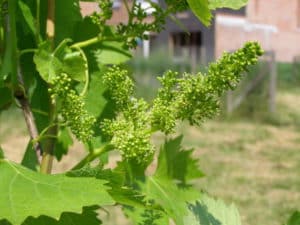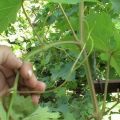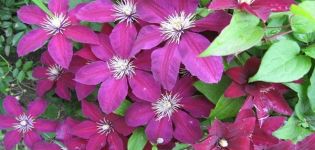Description and characteristics of the long-awaited grape variety, yield and cultivation
The useful composition and high taste characteristics of Long-awaited grapes distinguish it from other varieties. The fruits have a harmonious, sweet taste and ripen early. Table grapes bring a large harvest and do not require specific care.
Breeding history of the variety
The long-awaited hybrid grape variety was bred by an amateur breeder VN Krainov from Russia. The species Talisman and Radiant Kishmish acted as a parental pair.
Advantages and disadvantages
The long-awaited grape is prized for its many benefits. These include:
- Early fruiting. The ripening time of the bunches is from 105 to 120 days.
- Resistant to low temperatures. Plants are able to withstand cold weather without additional insulation.
- High productivity. Each season, large clusters of up to 1.5 kg ripen on the bushes, the number of which exceeds the average.
- Simplicity of care. For a stable large harvest, you do not need to use special agrotechnical techniques - it is enough to adhere to the standard care rules.

External characteristics
A good presentation is an undoubted plus of the Long-awaited variety. Vines are often used for design purposes - to decorate country houses and gazebos.
Bush and shoots
The shrub of grapes is spreading and tall, characterized by intensive growth and rapid growth. The green mass quickly grows on the bushes, regardless of how the grapes are planted - by grafting or using a seedling.
Each bush forms 20-25 shoots, and the total area of one plant is 5-6 square meters. m.
Harvest quantity and fruit description
One bush can grow up to 10 kg of grapes. Dense clusters weighing from 0.6 to 1.5 kg have a conical shape and retain their marketable appearance well after harvest.

Fruits weighing 7-12 g differ from other varieties in large size and narrowed shape. The color of the berries is yellow-green, turning into amber by the time of full ripening. The taste is harmonious, sweet and sour. The skin of the fruit is very thin and barely perceptible. The pulp is of medium density, juicy and quite fleshy.
As a rule, there are no seeds in the fruits, or there is only one dense soft seed.
Resistance of grapes to diseases and frosts
The Long-awaited variety is resistant to many common diseases and cold weather. The average degree of susceptibility appears to downy mildew. The risk of injury covers the entire ground part of the bushes. To protect plants from infection, it is required to periodically spray with fungicidal preparations and provide ventilation of the bushes.

In what areas is it recommended to plant
The characteristics of the Long-Awaited variety make it suitable for cultivation in the remote northern regions, where there are not enough sunny days for other varieties to ripen. The grapes require constant natural light and minimal rainfall.
Features of planting and growing
Long-awaited grapes develop better and bear fruit when grown in loose soil. For a seedling, a hole is dug with a diameter of 80 to 100 cm and a depth of up to 65 cm.In case of significant freezing of the soil, the seedlings are laid to a depth of 80 cm.The clay soil is diluted with sand, crushed brick or crushed plaster, and the sandy soil is flavored with rotted manure. A pit for spring planting is prepared in the fall, and having planned a planting in October - 2-3 months before laying the seedlings in the ground.
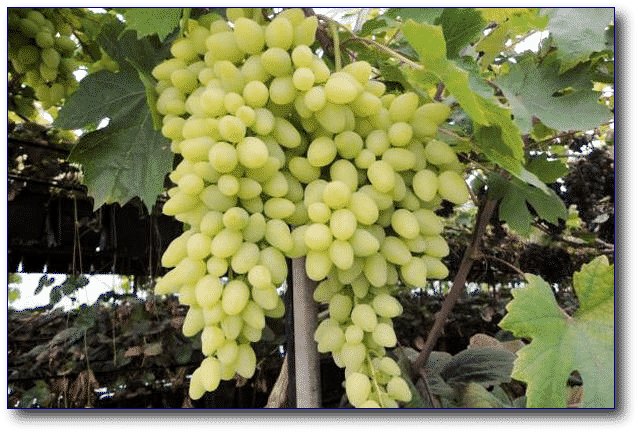
Disembarkation scheme and timing
You can plant grapes in early spring or autumn. The choice of the period depends on the region, climatic conditions and the stage of development of the seedling. In the spring, it is recommended to plant cuttings or fragile seedlings that have time to take root well during a warm period.
In the fall, it is better to plant bushes with developed roots and woody vines, as they can withstand the cold winter without risk of death.
When planting the Long-awaited variety, you can adhere to the standard planting scheme. It is required to leave a distance of about 1.5 m between each bush for free growth of the roots and the ground part. Optimal row spacings vary between 1.5-1.8 m.
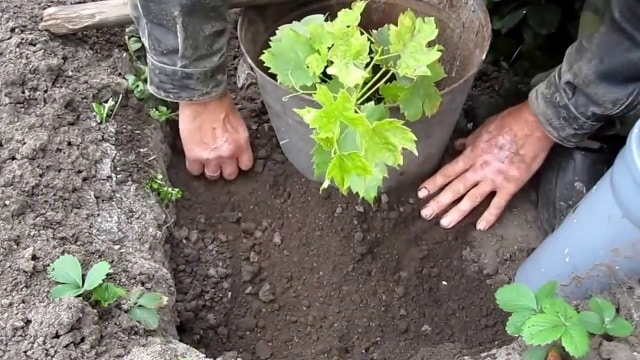
Watering and fertilizing
When planting plants, the first top dressing is introduced into the pit. The fertilizer dose depends on the degree of soil fertility at the site and is 5-10 kg. Organic ingredients mixed with superphosphate are used as top dressing. Top dressing is poured to the bottom of the pit and contributes to the correct and active development of the bushes. During the further growth of grapes, it is recommended to fertilize the plants with wood ash and phosphorus-potassium substances.
Watering the bushes is performed as the earth dries up. For the first time, it is necessary to water the seedlings immediately after planting to compact the soil. With average precipitation, the number of irrigations during the season does not exceed three. It is important to avoid waterlogging, since the excess presence of liquid will provoke rotting of the roots and the subsequent death of green spaces.

Cutting technology
Pruning and shaping of vines is carried out to remove old and rotten branches, reduce foliage thickening, give a decorative appearance, and provide access to the sun and air to the fruit. If you plan to cover the bushes for the winter, then pruning is performed 2-3 weeks after the leaves fall to simplify the work.
In the absence of winter shelter, it is best to prune the bushes in the spring to allow the plant to adapt during the warm season.
Mulching
In order for the grapes to develop intensively and bring a harvest, it is necessary to mulch the soil around the bushes annually. For this purpose, plant materials are used, which are laid in a layer 5-10 cm thick. Sawdust, straw, foliage and peat are suitable as a mulching material for the Long-awaited variety.The mulching process retains moisture at the roots of the grapes, saturating the soil with air and preventing crust formation. The conditions created with the help of mulch are favorable for the vital activity of beneficial microorganisms in the soil.
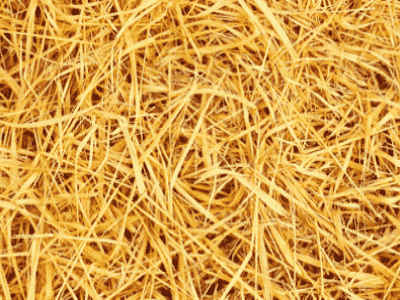
Preparing the vine for winter
In the middle zone of the country, grapes are recommended to be covered for the winter. A dense reinforced film or burlap is used as a covering material. To properly cover plants, the following features must be considered:
- The grapes are covered after the first frost. It is enough for the bushes to be unprotected for a couple of days at a temperature of about -8 degrees. Hardened vines due to the developed immunity are better preserved until spring.
- Early shelter leads to the development of rot and subsequent death of plants.
- Bushes should be provided with fresh air for their full development and ventilation.
- Before covering the vines, they are treated against pests and diseases. The development of infection or insect infestation of a sheltered plant will not allow the problem to be detected in time.
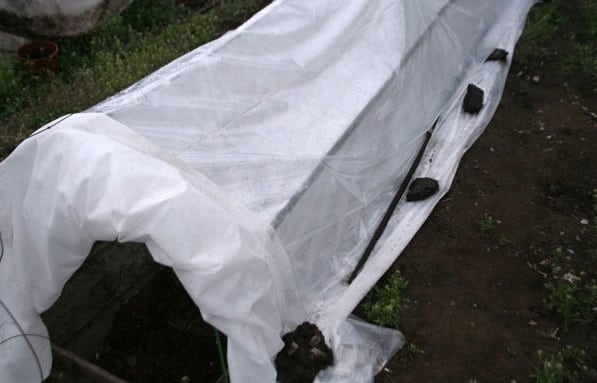
Prevention of diseases and pests
Despite the high resistance to a number of infections and pest attacks, it is recommended to carry out preventive spraying with protective agents several times during the season. For prevention, it is enough to carry out 3 treatments per season.
When to wait for the first harvest
Subject to timely spring planting, the first fruits ripen in the second half of August.
The specific timing of the ripening of the crop directly depends on the surrounding climatic conditions, the growing region, the type of soil, fertilizers used and the specifics of care.
Ripe fruits can be visually distinguished by their pronounced amber color. It is recommended to pick only those bunches on which all the berries are ripe. The yield from one bunch can reach 1.5 kg.
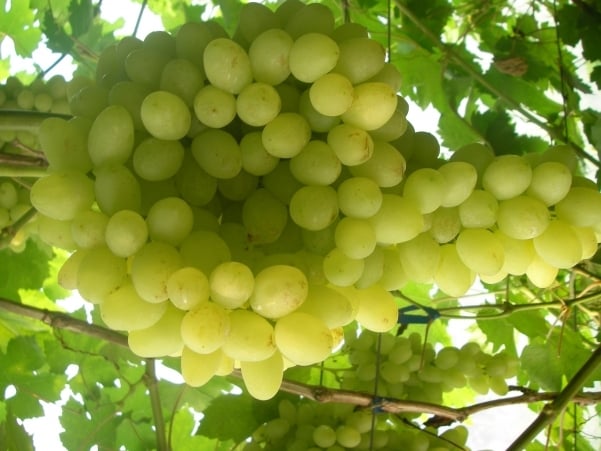
Fruit ripening period and harvest
The vegetation process of the Long-awaited variety is 105-120 days. Other varieties have a longer growing season, which is why the variety is classified as early ripening. When harvesting a ripe crop, it is recommended to follow a number of rules so that the berries do not lose their high taste characteristics. In particular:
- you need to harvest the fruits immediately after ripening, since early harvesting will exclude the possibility of ripening, and overripe berries will begin to deteriorate;
- ripe bunches are recommended to be carefully cut with pruning shears so as not to damage the vines;
- the optimal time for harvesting fruits is the first half of the day, when the dew comes off the brushes;
- dried and damaged berries from whole bunches are removed with scissors, without dividing the bunch into several parts.
After picking the berries, they are carefully examined to select rotten and unripe specimens. If it is necessary to leave part of the grapes for storage, it is important to select only high-quality fruits in order to exclude spoilage of the rest of the harvest.
In what areas are berries used
Taste qualities of the Long-awaited variety of fruits allow the use of grapes for fresh consumption, freezing, processing. Also, berries are widely used in the production of juice and wine. This variety has a good keeping quality and is able to be stored for further use without loss of taste.
